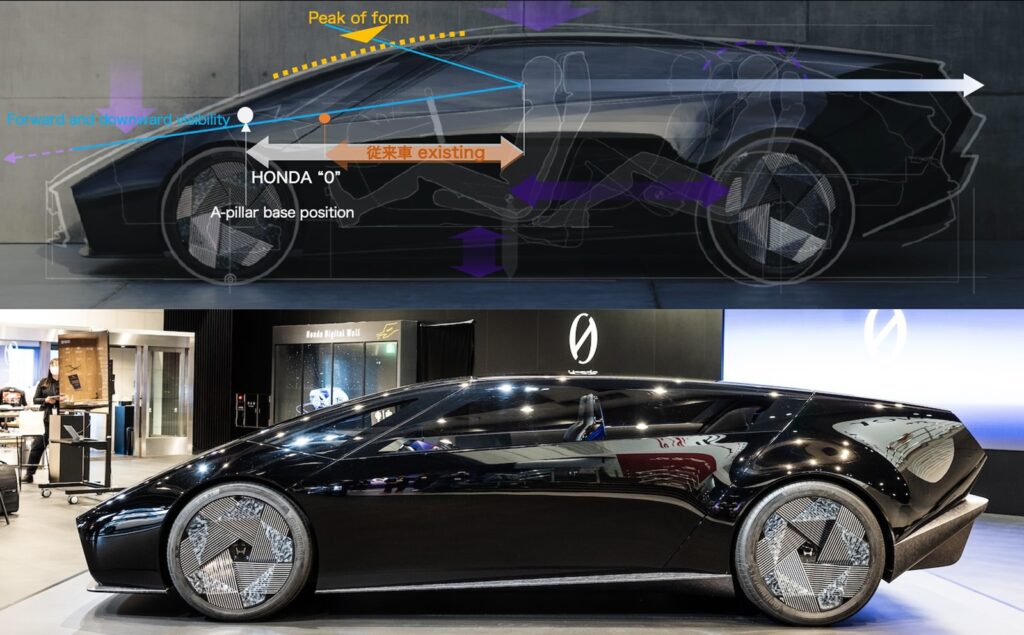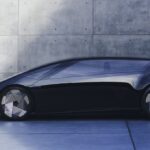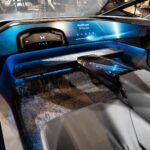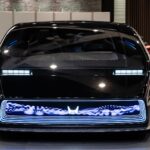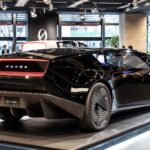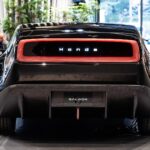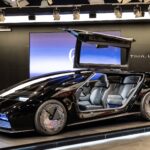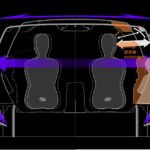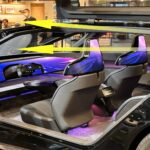目次
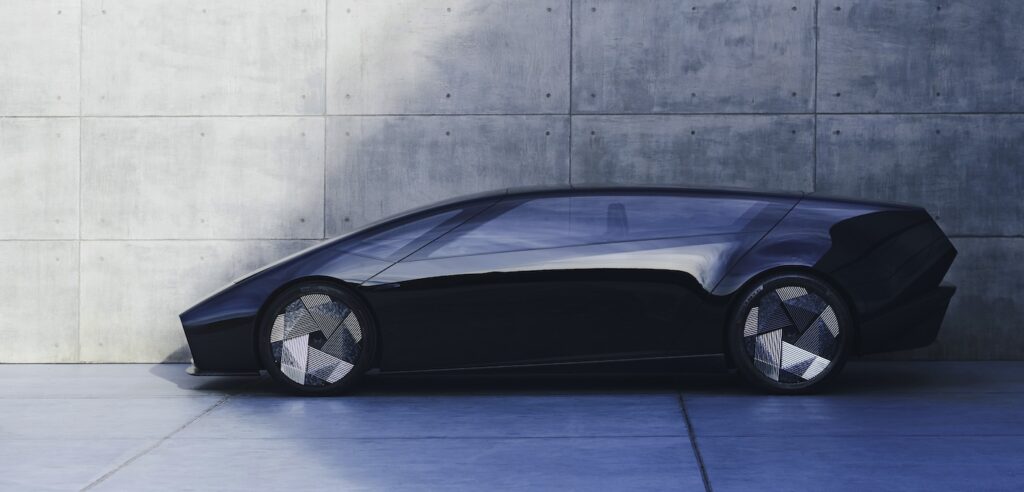
プランビューで明かされるゼロ・サルーンのMM戦略 極めて数学的に計画された造形アーキテクチャー
EVであることと、ただ動力が変わったという以上にどうすればお客様に新しい使用価値・経験価値・所有価値を提供できるかという思想のもと、ホンダはホンダらしく組立てる目標をもったこのためのパッケージを考察し、ゼロからアーキテクチャーを根本的に見直している。”ゼロ”の意味はこれまで長らく続けてきた自動車のパッケージ組み立てとは一旦決別し、改めてなにができるか、を考えている。そしてその根本思想はやはりMM(マンマキシマム・メカニミマム)か。
このコンセプトカーは北米で開催されるショーでの展示の見栄えなどを考慮してやや誇張気味の諸元値(特に最大幅)を持たせていると推測するのだが、しかし車種セグメントにかかわらず車体を構成する全幅を最大有効に使い切るという考え方を、それを次世代EV車におけるホンダの根本姿勢であるということを訴求しているのだろうと受け取った。
また従来は車体前方に存在していたエンジンがいなくなったことをお客様満足にどう活かせてゆけるのか、ホンダの目指す新しい「移動の喜び」の考えをどう示せるのかも提示している。
MM思想の最大化のために
ゼロ・サルーンではお客様ファーストの空間提供を最大にするためのデザインが行なわれているので、ここからその造形の成り立ちを解析してゆこうと思う。
まずゼロスタートの最大特徴は通常の「重ね餅セクション」を取らないというところ。
重ね餅セクション(凸型)は上級車=車幅のある車、の車格感を表現するセオリーとしての立体構成の考え方であるし、これまでこの慣例に従うように、量産車のヒエラルキーに基づいたカーデザインが行なわれてきた。ホンダはまずはここから打破してきた。
※重ね餅とは日本の正月に飾る鏡餅のことで、大小2つの米をついた餅を重ねて飾る。
さらに重ね餅(凸型)の上の段(ガラスキャビンの部分)を斜めの傾きの強い台形にすることで感じる「スポーティ」であるという定番の意識からも訣別している=次世代のスポーティさへの挑戦。
ゼロ・サルーンの外観が目指すのは「ひと目見た時の圧倒的な違い」を創り出すこと。“これまでに見たことがない”“今までとは違う”と、年齢層に関係なく一般のお客様が感じることが目標だ。
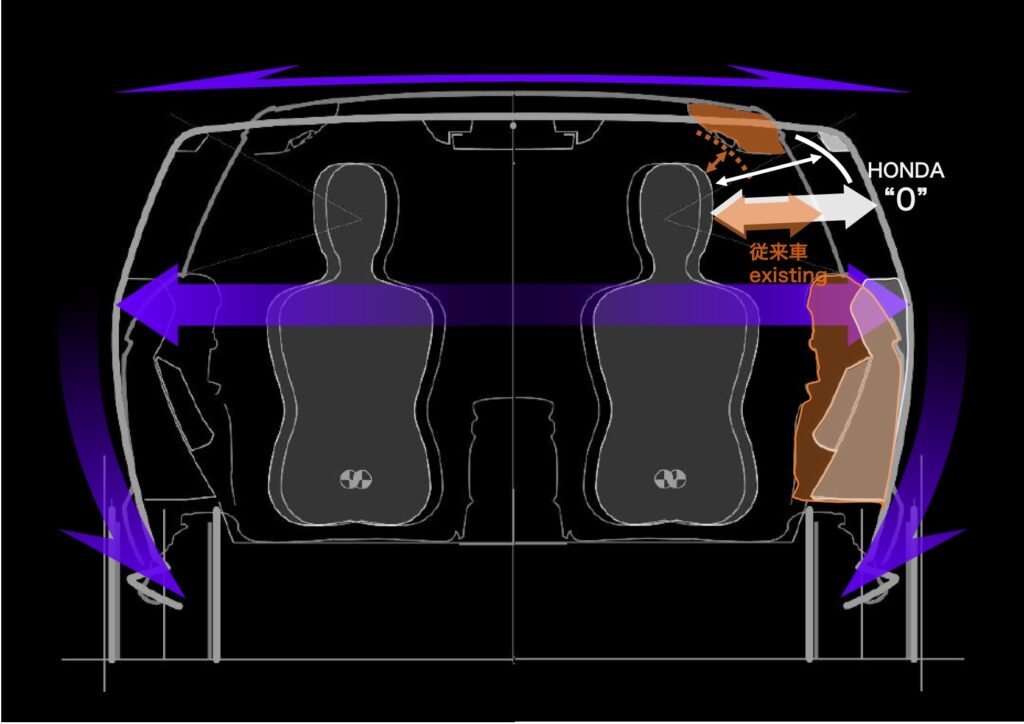
そのために造形のセオリーを捨てたところからがスタートだったのだと推測する。セオリーに囚われていては表面的な違いしか作れない。そしてそれは往々にして本来なら取り去りたい装飾的な要素をイタズラに増やすことにしかならないからだ。
そして彼らは人の入る空間からMM思想の考察を始めている。
これまでの室内の組み立て方にとらわれずにお客様ファーストで全てを見直していて、ごく自然に、ごくシンプルに、人が広く感じるのは(あるいは狭く感じないのは)どういう空間なのか、空間性を顕著に感じるのは人のどの感覚から得られているのか、ということを雑音無しに設計する。組み立てる。そのためには数値の持つ効果を使い切ることを徹底した。
1番目は:顔の横にあるガラスまでの距離。タイトな車になるほどサイドガラスは乗員の顔や側頭部に近づく。人はこれを敏感に気配する。ならばガラスは立ててしまえばいいじゃないか、という素直な考えに立つ。
(倒せば倒すほど、サイドウィンドウを開けた時に雨が入り込むし、直射日光も浴びる)
2番目:人は前を見るときに、自身の視野(視界範囲)のなかで顔位置よりも前方が広がっていると実寸以上に広く感じる、という科学。これを活用するためにサイドウィンドウ下端のラインは前方に向かって下げてゆく(外からみるとこれはウェッジ的な後ろ上がりのラインとなる)。これで乗員は水平視界と前方下部視界が広がりワイド感を実寸以上に感じる。さらに斜め前下方の直接視界は車を操る上でドライバーには大切な情報源でもある。
ルーフやフロントウィンドウも上方から覆い被さるような「狭さ」を感じさせるようなことをしない。サイドビューでの車体カーブのフロントウィンドウのピークの位置をみれば一目瞭然。フロントガラスを倒せば良いというものではない。
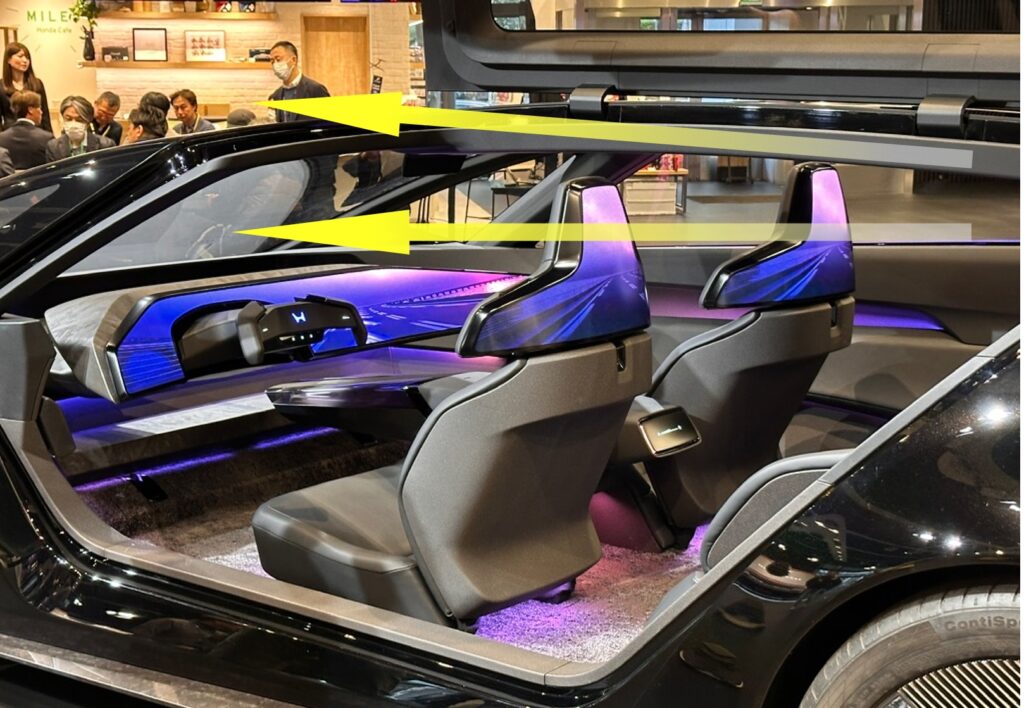
3番目:人は実寸で距離のあるものは、事実として遠く広く感じる。
これまで経験(体感)したことのない車室内での距離を体験させる。乗用車というカテゴリーのなかでは感じられなかった実寸法を実現させる。という目的のためにAピラーを遠くに配置する。そして左右のAピラーの付け根間の幅寸法を最大化させる(正確にいうとここはAピラーではない。この車のAピラーはドアの開口前端部にサイドシルまで到達して存在している。だがこの記事では便宜上Aピラーと呼ばせていただく)。
私は思わず1985年に販売されたホンダトゥデイを思い出した。当時、軽自動車のスタイリング発想を根本から覆した軽自動車の登場に愕然としたのを思い出す。クラスレスの圧倒的な前席の広さを持ったトゥデイは非常に魅力的だった。当時軽自動車をデザインしていた私にとっては本当に大きな衝撃だった! 自分の頭の中に、こういう考えが思い浮かばなかったことに大きなショックを受けたのだ。

軽自動車なので全幅は自由にならないなかで、Aピラー付け根を遥か前方(そう感じた)に持って行くことで、軽自動車よりも格上の小型車に迫らんとする前席の広さ(長さ)や空間性を作り出していた。さらに軽枠ギリギリの軽自動車なのでボディ側面はほとんど平らであり、だからAピラーもほとんど最大幅の位置にあった。ということもゼロ・サルーンに重なる。
おやっ?ホンダゼロ・サルーンのアーキテクチャーの原点はこれか???彼らは経験済みなのだ!

4番目:前方下方視界が確保できたのはEVパッケージだからこそである。
電費向上のために空力性能を向上させる→そのためには前面投影面積を小さくしたいが全幅を広めにとると、全高を下げなければならない→乗員を低く座らせると前方視界が悪くなる。仮にミッドシップレイアウトであればカウル位置を下げてフロントウィンドウ下端を下げることも可能だが、前方にエンジンが積まれているレイアウトのクルマではそれができない。
ゼロ・サルーンはフロントにエンジンがないのでフロントウィンドウをヘッドランプ位置まで下げることが可能だった。そしてそのカウル(インパネ最前端)の高さはサイドウィンドウと連続する位置であり、乗員からみるとぐるりと連続して視界が開けているように見える。実際に内装造形も一周連続でぐるりと造形している。そしてその造形のテーマを妨げないようにインパネはフローティングさせている。
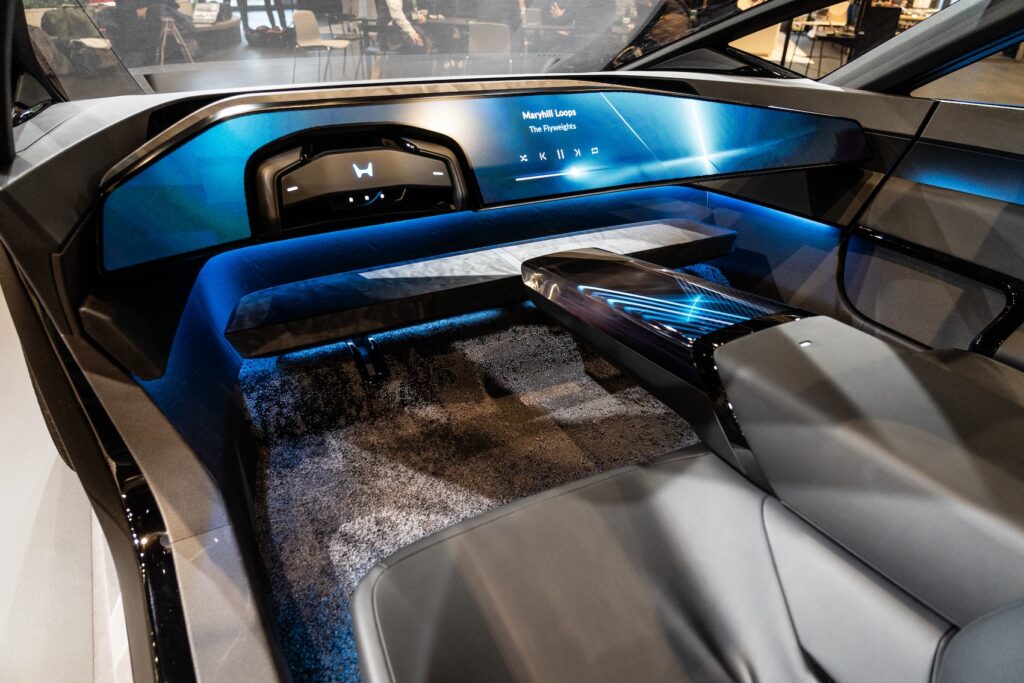
5番目:全高を低くすれば乗員の頭上空間は狭くなる。床はバッテリーで上がってきているので上からも下からも攻められて室内上下寸法を十分に取ることが難しい。それを少しでも緩和するために頭上のルーフはガラスルーフとしたのだろう。ガラスルーフにすれば天井を覆うトリムも必要ないからだ。とはいえ、これらはあまり実用上の処理とは思えない。量産するとすれば何か他の解決策が必要になるはずだ。
このように計画され組み立てられた室内の景色がこれまでとは違う新たな空間演出になっていて、ホンダはこのような空間の中で移動することを新たなエクスペリエンスの提供だとしているのだろう。
低くワイドに構えた外観でハッとさせ、魅力を感じさせて、車に乗り込めばさらに新たな感覚に包まれるように仕組まれている。このドラマ性こそが今回ホンダが発表した、The art of resonance につながるのだろう。
平面図に解あり
ここから外観に目を向けてみよう。
MM思想達成のための室内空間の最大化がエクステリアのスタイリングの特徴にもなっている。さらに外観には空気抵抗との戦いという物理的な要求も絡んでくる。
まずシルエット。
サイドシルエットはエアロダイナミクスから出された典型的な形状である。
現状EVでは電費は最大課題。空力最適化は世界中のメーカーが取り組んでいる。
そのためにルーフ後半は徐々にスムーズに下がりつつ後方へ伸びる。
こうなると後席ヘッドルームの確保には好都合だが課題は後方視界。
直接視界の確保が困難であるが、それは後方カメラで対処するとしている。

リヤシートの横幅の広いヘッドレストの形状を通常程度の大きさにすれば後方の視界はある程度確保できるようにも見える。直接視界がまったくないのと、視界を得られるのとではどのように受け取られるだろうか。下手に直接視界を確保しようとしてしまうと、いくら基本は後方カメラだと位置付けていても「狭い」「見えない」という声が必ず上がるだろう。それならばカメラの画像で死角無しの後方情報にした方が安全につながるかもしれない。
次にヘキサゴン型のボディセクション。このヘキサゴンのサイドのトンガリ(折れ)を形成するラインがボディサイドの見え方を鋭くスポーティに見せている。しかもそのトンガリはボディ最大幅を形成しながら強くウェッジしていて、前端は最大幅のままフロントホイールまで達している。
そこにフロントウィンドウAピラーの付け根の最大幅がくるので、先ほどのインテリアの空間の3番目の話とシンクロする。
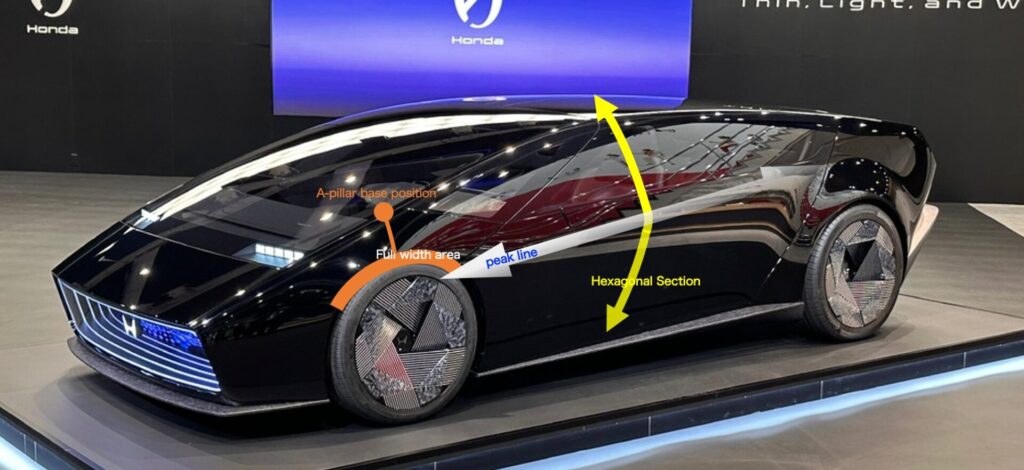
ルーフサイドショルダーからフロントウィンドウのAピラーを通り、フロントエンドのスクエアな光のセクションの角に達するラインどりがゼロの外観特徴でもあり、新しい部分である。その動きは正面から見るとソロバンの玉の形のように見える。
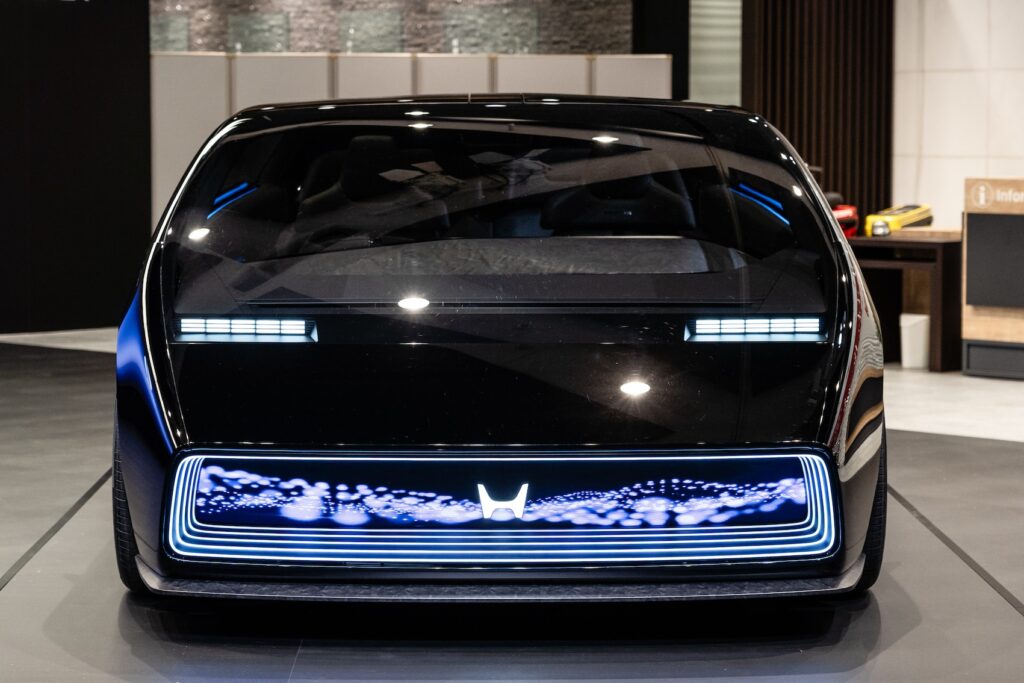
そしてこのヘキサゴン型のセクションはボディ後半に行くに従って、平面で内側へと絞り込まれながらヘキサゴン下半部の角度を広げてゆく。ゆえにボディサイドの折れ線は次第に強さが消え緩くなりリヤホイールアーチフレア形状に溶け込んでしまう。
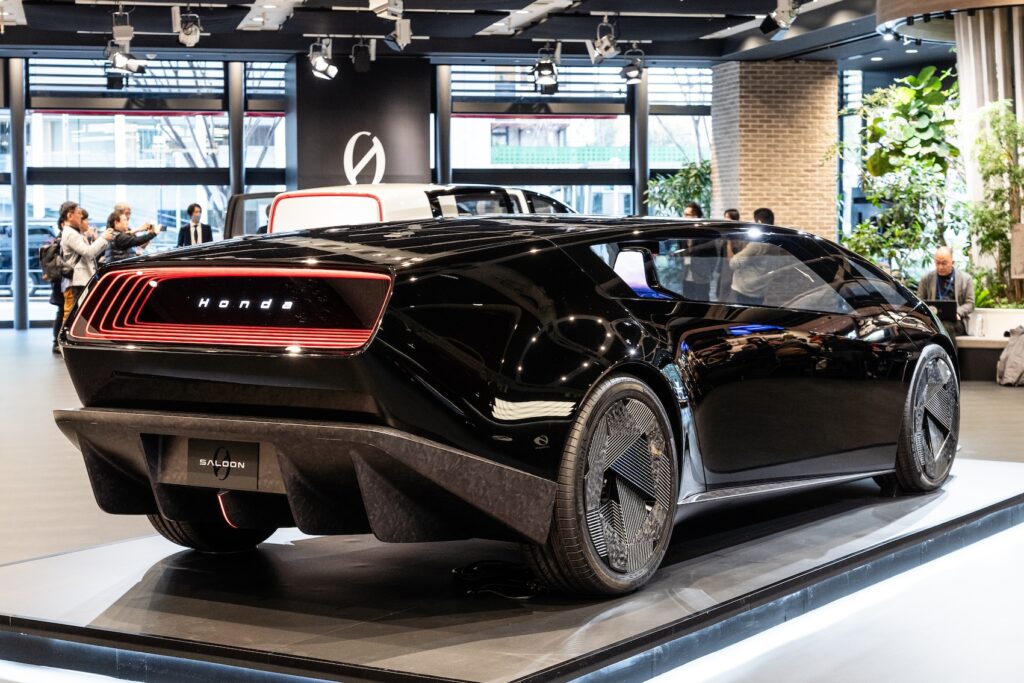
このリヤホイールアーチあたりではボディは十分に絞られているのでリヤフェンダーとリヤホイールが横に張り出し凸型の踏ん張った姿を見せるように計画されている。ルーフサイドのショルダーラインが後席を超えたあたりからの後方への絞り込間れている動きを見れば一目瞭然だ。
そしてこのリヤホイールアーチのフレア形状でヘキサゴンは完全に吸収され、リヤホイールの後ろ側にはもうその姿はない。
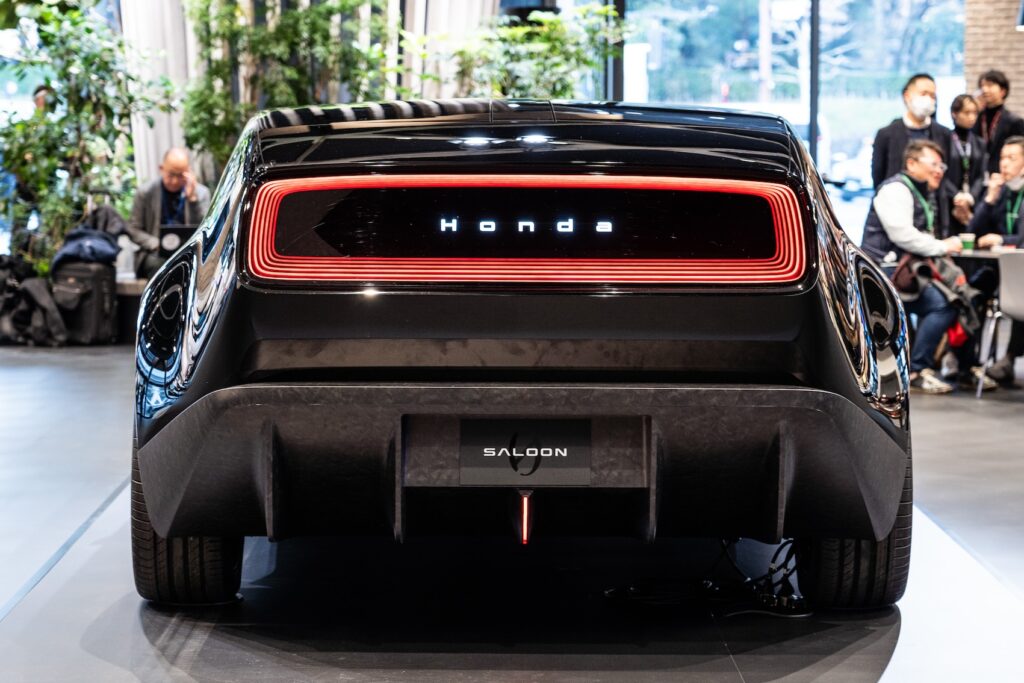
ゼロのスタイリングの特徴はプランビュー(平面図)に如実に現れている。クルマはプランビューが面白い。
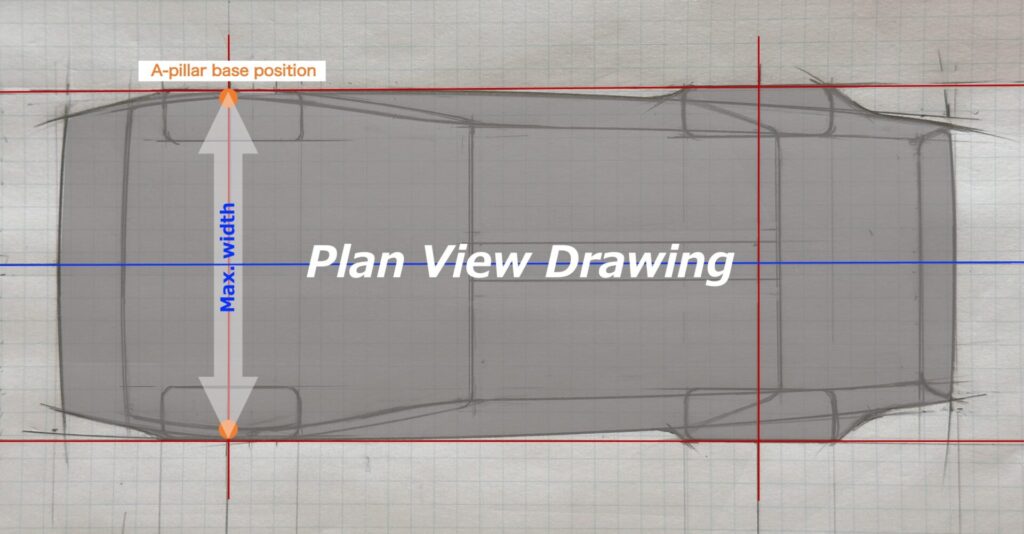
ホンダゼロサルーンは非常によく計画され極めて理詰めで計画されたスタイリングだ。
カウンタックのようだという人がいるが、まったくの別物だ。私にはまるでそう見えない。
しかし課題もある
・例えば前輪のサスペンションストロークなどをどう稼ぐのか(どんな形式のフロントサスペンションとするのか)。この視界性のコンセプトを最大に示す造形パートをどこまで実現してくるかは見ものだ。
・ガラス成形は可能だろうが車体重量との折り合いはどうつけるのだろうか。ガラスの面積が広くなればなるほど車両重量が増す。電費向上には車体重量は非常にシビアなはず。せっかく電池重量を軽減したのに、である。
・車体剛性を確保するのに本当に大きく上方に開く1枚ドアの採用は良い方法ではない。センターピラーも本当に必要がないのだろうか。この大きなドアを上げ下げし、強度も確保するために、さらに重くなる要素が増えてしまわないか?
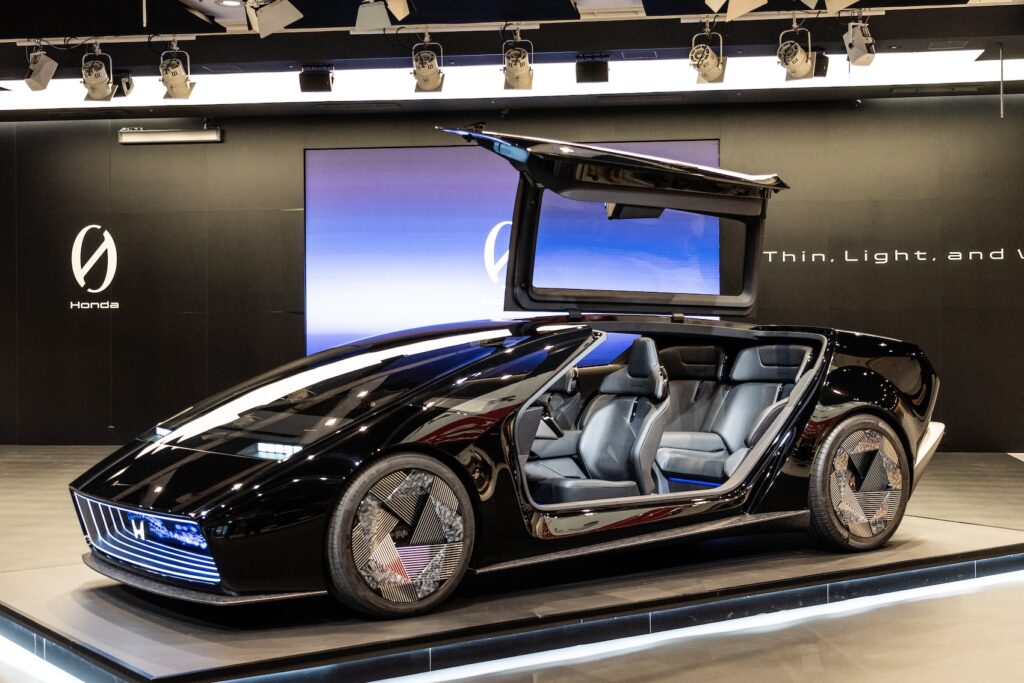
デザイン
今回ホンダは次世代EVへ向けてお客様価値を最大化させるためにすべてを見直した。そしてその考えを形にして可視化した。このような開発のスタートからクルマのコンセプトを考察してカタチに表現するまでのプロセス、行為、考察すべてを”デザインする”という。デザインとはそのようなプロセスを指す。=そう!目に見えるカタチだけを指すのではないのです!そしてこれらのプロセスを考え構築することこそがデザイン部門の役割である。
高い運動性能で操る喜びを確保するのがホンダ
それと同時に常に独自な新しさを追求するのがホンダ
ゼロシリーズは次世代に向かい、その両立を目的として新たな車づくりのコンセプトを表現しているようだ。
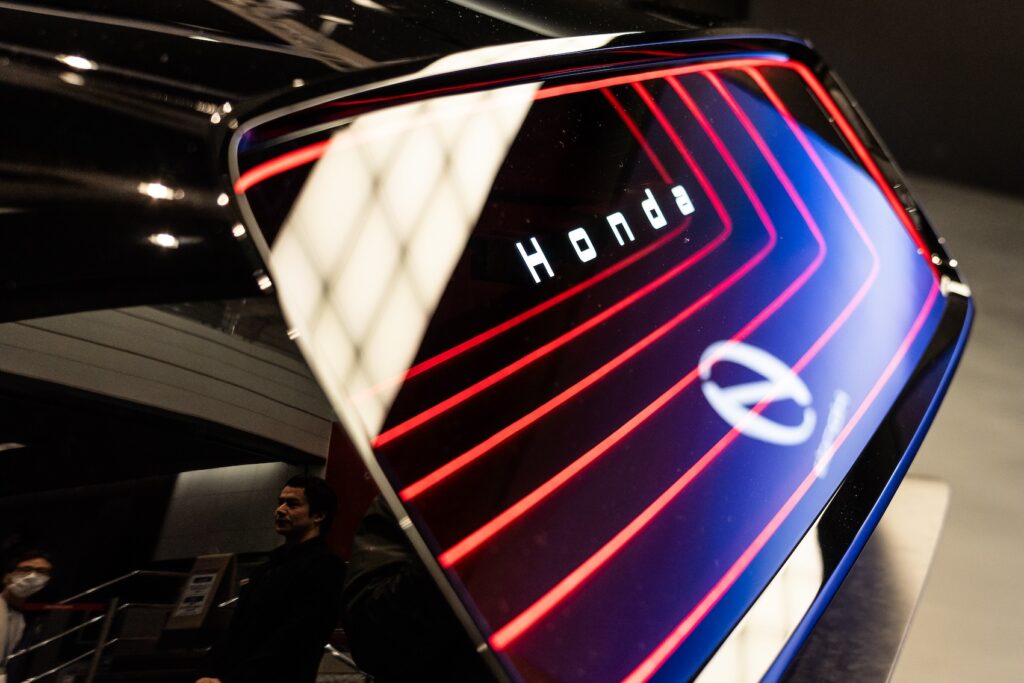
Zero Saloon’s MM strategy as seen in the plan view Extremely mathematically planned formative architecture

Honda is fundamentally reexamining its architecture from scratch, with the goal of creating a package that is unique to Honda, based on the idea of how to provide customers with new values of use, experience, and ownership beyond the fact that it is an EV and that its power source has changed.
By “zero,” Honda is breaking away from its long-standing automotive packaging plan and considering what it can do once again.
And the fundamental idea is still MM.
We assume that the concept car has somewhat exaggerated specifications (especially the maximum width) in consideration of its appearance at the show in North America, but I took it to mean that Honda’s fundamental stance in next-generation EVs is to maximize the effective use of the overall width of the vehicle body, regardless of which segment the car is in.
It also shows how the engine, which used to be located in the front of the vehicle, can be removed and how it can be utilized to satisfy customers, and how Honda’s new concept of “joy of mobility” can be demonstrated.
To maximize the MM philosophy
The Zero Saloon is designed to maximize the provision of a customer-first space, and we will now analyze the origins of its formulation.
First of all, the greatest feature of Zero Start is that it does not take the usual “overlaid rice cake section”.
The “overlaid rice cake section” (凸:onvex shape) is a three-dimensional configuration concept that expresses the sense of car size of a high-end car (usually a wide car), and until now, car design has been based on the hierarchy of mass-produced cars in order to follow this customary structure.
Honda has first of all broken down from this point of view.
※The ” overlaid rice cake” refers to the rice cake (called Kagami-mochi) displayed at New Year’s in Japan, which is made of two rice cakes, one large and one small, stacked on top of the other.
Furthermore, it also breaks away from the standard notion that “sporty” is a trapezoidal shape with a strong tilt in the upper section (the glass cabin) of a overlaid cake (convex shape) = a challenge to the sportiness of the next generation.
The goal of the Zero Saloon exterior is to create an “overwhelming difference at first glance.
The customers, regardless of age, should feel that they have never seen anything like it before, or that it is different from anything they have ever seen before.

We assume that the starting point was to abandon the theory of modeling in order to achieve this. If you are stuck in theories, you can only make superficial differences. And this is because it often leads to an increase in the number of decorative elements that one would normally want to remove.
And they have begun to consider the MM philosophy from the space where people enter.
They are reviewing everything from a customer-first perspective, without being bound by the conventional way of constructing a room. They design without any noise, very naturally and simply, to find out what kind of space makes people feel spacious (or not so spacious), and from which senses people can noticeably feel the spatiality of the space. To achieve this, they made sure to exhaust the effects of the numbers.
No.1: the distance to the glass next to the face. The tighter the car, the closer the side glass is to the occupant’s face and side of the head. People are sensitive to this. They stand on the honest idea that if that is the case, why don’t we just raise the angle of the glass?
(The more it is tilted, the more rain will enter when the side windows are opened, and the more direct sunlight will be exposed.)
No.2: When people look ahead, they feel that the area in front of them is wider than their actual size if it is wider than their face in their own field of view (field of vision). This is a science.
To take advantage of this, the lower edge of the side windows are lowered toward the front (from the outside, this creates a wedge line that rises backward). This allows occupants to have a wider horizontal field of vision and a wider lower frontal field of vision than the actual size. In addition, the direct diagonal forward and downward view is an important source of information for the driver when maneuvering the car.
The roof and front windows also do not give a sense of “narrowness” as if they are covered from above. The position of the peak of the front window in the side view is obvious. It is not enough to tilt the windshield.

No.3: People feel that things that are distant in real size are in fact far and wide.
The A-pillar is placed far away for the purpose of letting people experience a distance in the cabin that they have never experienced (sensed) before, and to realize actual dimensions that have not been felt in the category of passenger cars. The width dimension between the base of the left and right A-pillars is maximized. (To be precise, this is not an A-pillar. The A-pillar of this car exists at the front edge of the door opening, reaching the side sill. For the sake of this article, however, we will refer to it as the A-pillar.)
I was involuntarily reminded of the Honda TODAY sold in 1985. At the time, I recall being astonished by the appearance of a K-car that radically overturned the styling conception of light cars. With its classless and overwhelmingly spacious front seat area, the TODAY was extremely attractive. It was really a big shock for me, who was designing K-cars at the time! I was greatly shocked that this kind of idea had never crossed my mind.

The width of the car was not flexible because it was a K-car, but by moving the A-pillar base far forward (or so it seemed), it created a front seat area (length) and spaciousness that approached that of an A-segment car, which is a higher grade than a K-car. Furthermore, since the K-car was just short of the K-frame, the sides of the body were almost flat, and the A-pillars were almost at their widest point. This also overlaps with the Zero Saloon.
Hmmm? Is this the origin of the Honda Zero Saloon architecture?
They have already experienced it!
No.4: It is only because of the EV package that forward downward visibility could be secured.

To improve aerodynamic performance in order to increase battery consumption rate→To achieve this, the frontal projected area must be reduced, but if the overall width is increased, the overall height must be lowered. →If the occupants are seated low, forward visibility will deteriorate. If the car has a midship layout, it is possible to lower the cowl position and lower the lower edge of the front window, but this is not possible for a car with a layout in which the engine is mounted in the front.
Since the Zero Saloon has no engine in the front, it was possible to lower the front windows to the position of the headlamps. The height of the cowl (the most front end of the instrument panel) is continuous with the side windows, and from the passengers’ point of view, it appears as if the view is continuous and open. In fact, the interior design is also formed in one continuous circle. The instrument panel is floating so as not to interfere with the theme of the interior design.

No.5: If the overall height is lowered, the headroom of the occupants will be reduced. Since the floor is raised by the battery, it is attacked from above and below, making it difficult to get sufficient interior vertical dimensions. To alleviate this problem as much as possible, a glass roof was probably chosen for the overhead roof. A glass roof would also eliminate the need for trim to cover the ceiling. However, I do not think that this is a very practical solution. If they were to be mass-produced, some other solution would have to be found.
The interior view planned and assembled in this way is a new and different spatial presentation, and Honda may consider moving around in such a space to be providing a new experience.
The low and wide exterior of the car is designed to “surprise” and “attract” you, and once you get into the car, you will be enveloped in a new sensation. This dramaturgy is what Honda has presented this time as The art of resonance.
The solution is in the plan view!
Let us now turn to the exterior.
Maximizing interior space to achieve the MM philosophy is also a feature of exterior styling. In addition, the exterior also involves the physical requirement of combating aerodynamic drag.
First, the silhouette.
The side silhouette is a typical shape based on aerodynamics.
Currently, battery consumption rate is the biggest issue for EVs. Aerodynamic optimization is being pursued by automakers around the world.
For this reason, the second half of the roof extends backward while lowering gradually and smoothly.
This is convenient for securing rear headroom, but the issue is rearward visibility.
Direct visibility is difficult to achieve, but this will be addressed by the use of a rear view camera.

It appears that some rearward visibility could be achieved by making the rear seat’s wide horizontal headrests about normal size. How would one perceive the difference between having no direct visibility at all and having visibility? If the driver tries to secure a direct view, there will surely be a reaction of “it’s too narrow” or “I can’t see” no matter how much the camera is positioned as a basic rearward camera. If that is the case, it may be safer to use the camera’s image to provide rearward information without blind spots.
Next is the hexagonal body section. The side lines created by the hexagonal folds give the body sides a sharp and sporty appearance. Moreover, the hexagonal line is strongly wedged while forming the maximum width of the body, and its front edge reaches the front wheel arches at its maximum width.
The maximum width of the base of the A-pillar of the front window comes to this point, which is in sync with what I mentioned earlier in No. 3 of the interior space.

The line that runs from the roof side shoulders through the front window A-pillars and reaches the corner of the square light section of the front end is an exterior feature of the Zero and a new part of it. The movement looks like the shape of a soroban beads※ when viewed from the front. ※Soroban is Japanese abacus.

This hexagonal section narrows inward toward the latter half of the body, widening the angle of the lower half of the hexagon. Therefore, the fold line on the body side gradually loses its strength and becomes loose, blending into the shape of the rear wheel arch flare.
At this position of the rear wheel arch, the body is narrowed enough so that the rear fenders and rear wheels are planned to appear convex and stepped over to the side. This is evident in the way the shoulder line of the roof side is narrowed inward from beyond the rear seats.

And this flared shape of the rear wheel arches completely absorbs the hexagonal section, which is no longer visible behind the rear wheel arches.

Zero’s styling characteristics are really apparent in the plan view. The plan view is an interesting aspect of the car.

The Honda Zero saloon has very well planned and extremely logical styling.
Some people say it looks like a Countach, but it is something else entirely. It looks nothing like that to me.
But there are also challenges
・How will the front suspension stroke, for example, be increased (what type of front suspension will be used?). It remains to be seen to what extent the modeling part that maximizes this visibility concept will be realized.
・Glass molding may be possible, but how to deal with the weight of the car body? The larger the glass area, the heavier the vehicle. The weight of the car body must be very critical for improving battery consumption rate. Even though the weight of the battery has been reduced.
・Such a large single door that opens upward is not a good way to ensure body rigidity. Is there really no need for a center pillar either? Wouldn’t raising and lowering this large door, as well as ensuring its strength, add an additional element of weight?

What is Design?
This time, Honda reviewed everything to maximize customer value for the next generation of EVs. And they have visualized their ideas into a form. In this way, the process, action, and consideration from the start of development to the expression of the car concept in form are all called “designing. Design refers to such a process. =Yes, that’s right! It is not only about the visible form! The role of the design department is to think about and build these processes.
Honda ensures the joy of driving with its high athletic performance.
At the same time, Honda is always pursuing unique newness.
The Zero Series is the expression of a new car-making concept that aims to achieve both of these goals as it heads into the next generation.


